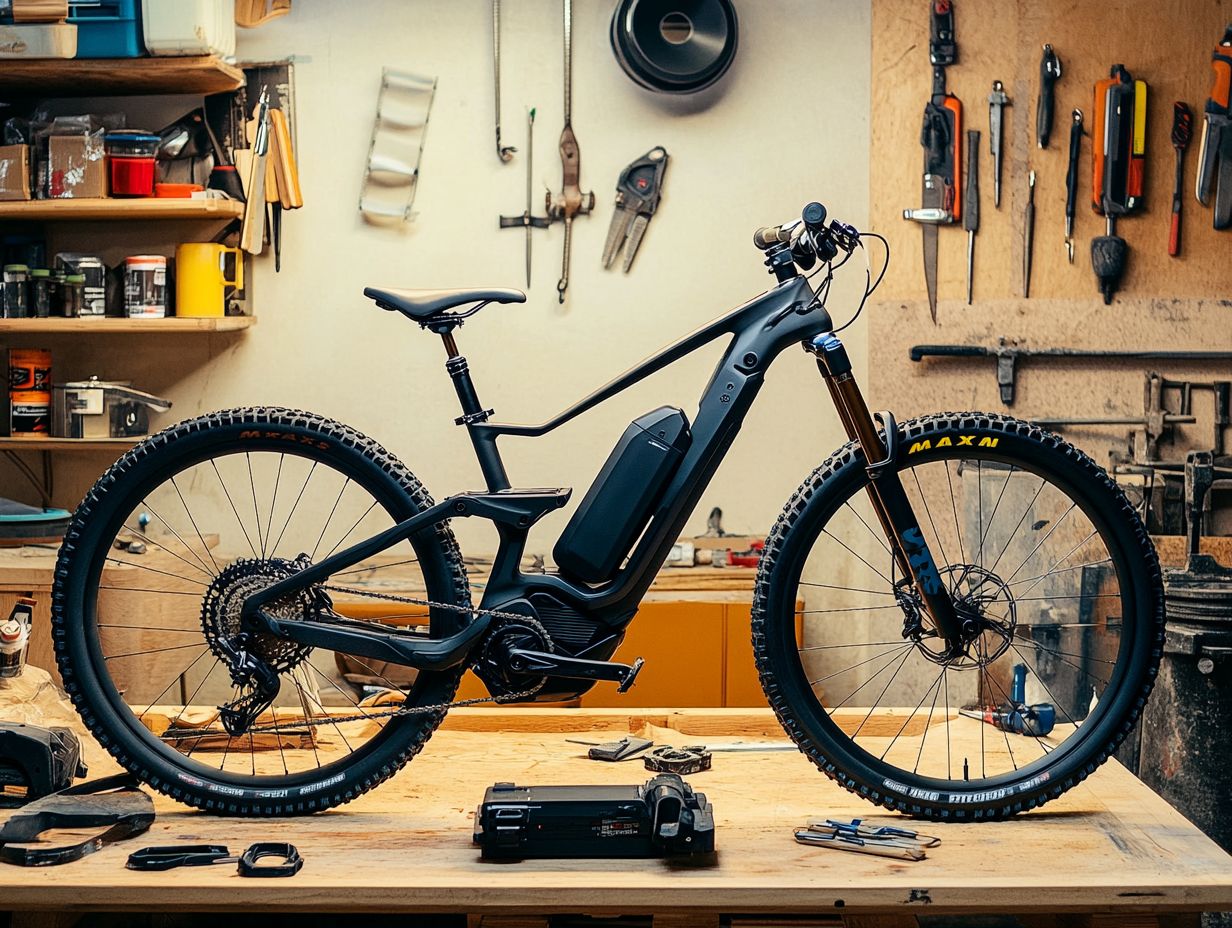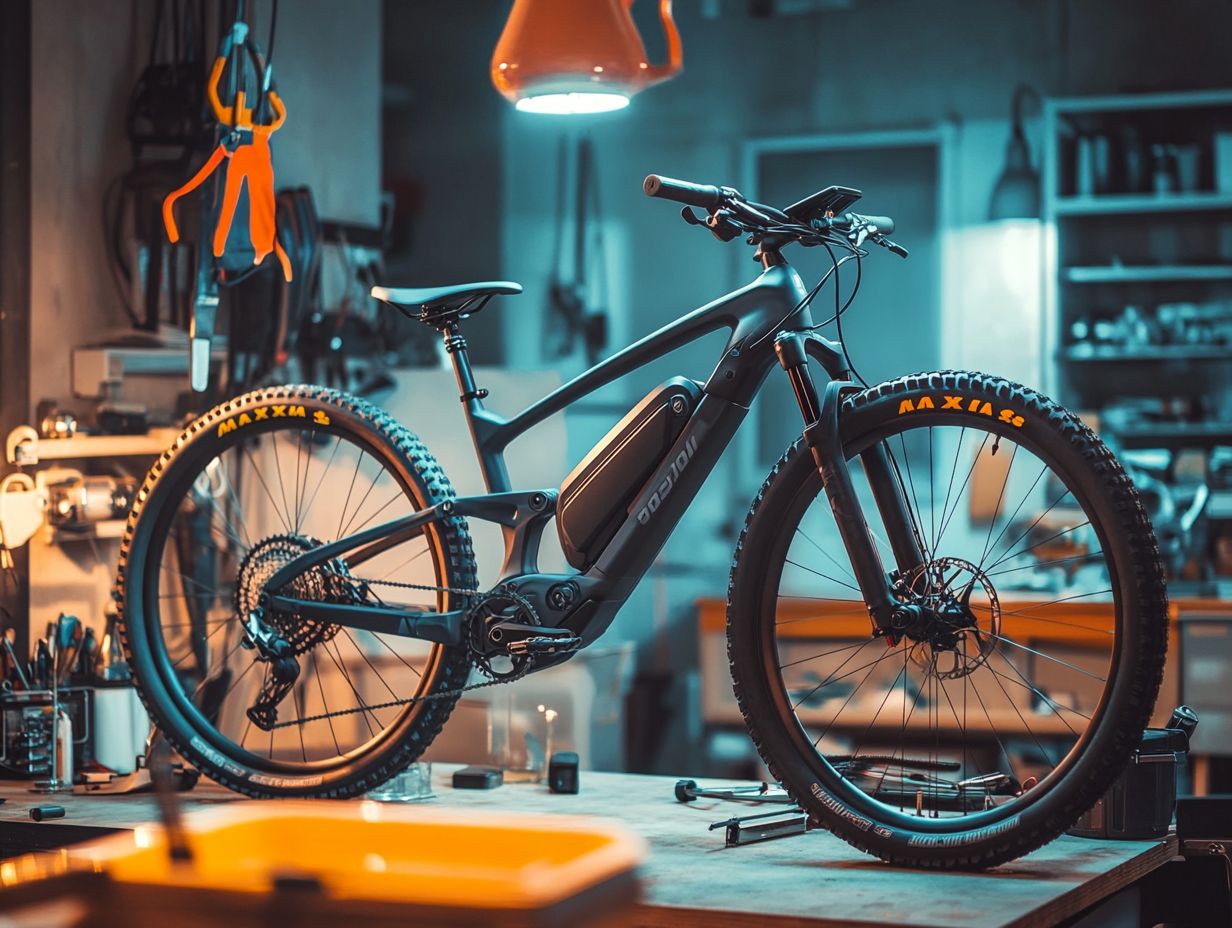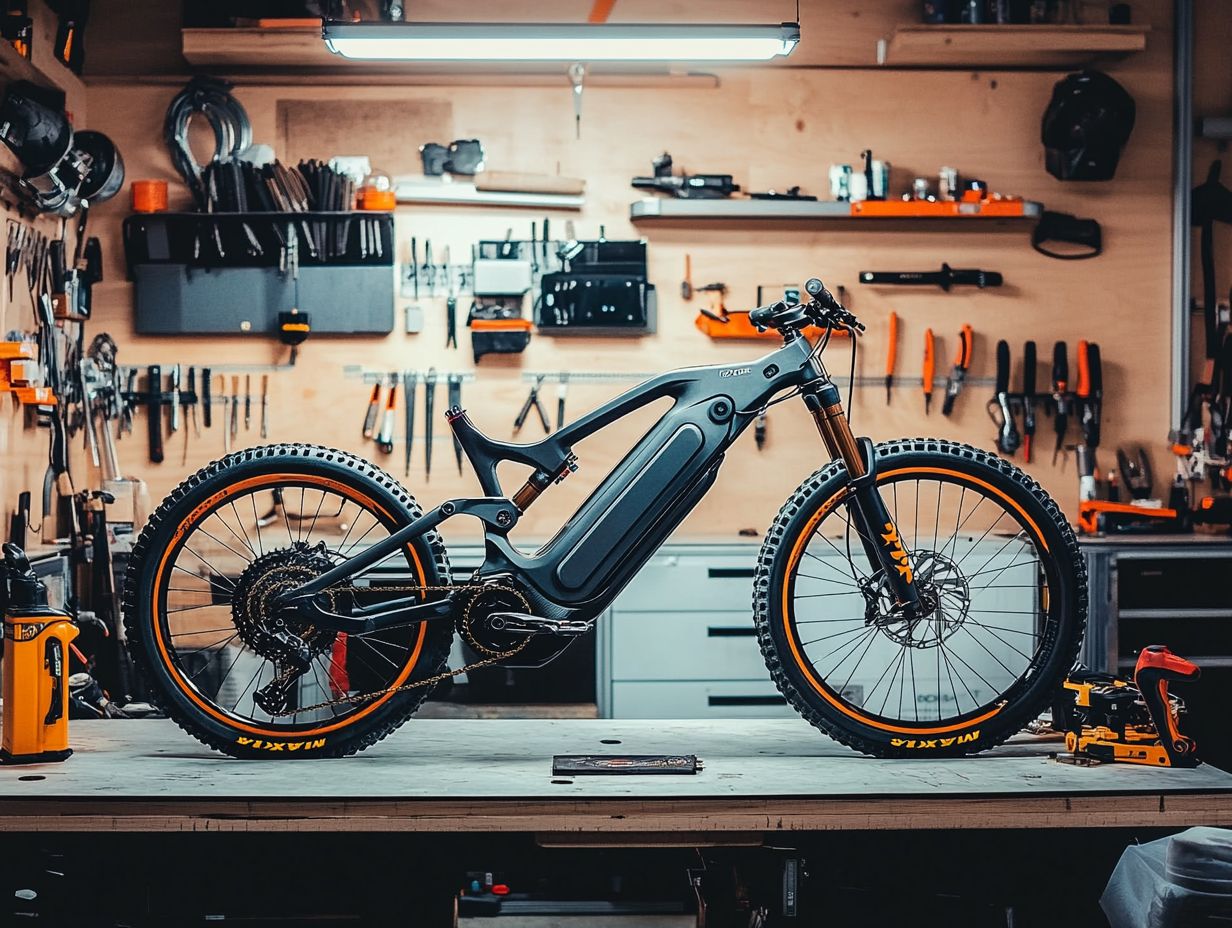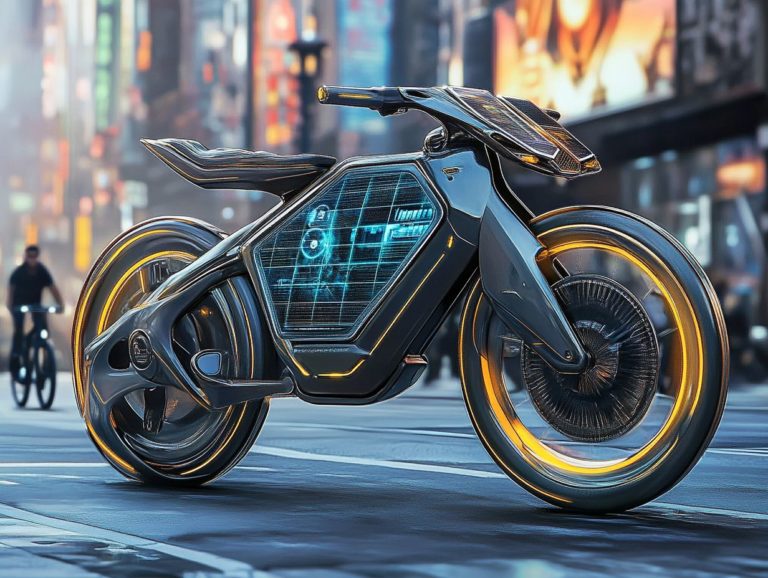Understanding the Mechanics of Electric Bikes
Electric bikes are revolutionizing your commute, merging the pleasure of cycling with the effortless boost of electric assistance.
In this exploration, you’ll discover what electric bikes are, the various types available, and how they operate. You will find a wealth of benefits highlighted, such as their positive environmental impact and cost savings, along with valuable insights to help you choose the ideal bike tailored to your needs.
You will also get essential maintenance tips to ensure your electric bike remains in peak condition.
Join us as we explore the thrilling world of electric biking!
Contents
Key Takeaways:

- Electric bikes are bicycles with an integrated motor that assists with pedaling, making it easier to ride and allowing for longer distances to be covered.
- Understanding the components and functionality of electric bikes is crucial to knowing how they operate and how to properly maintain them.
- Electric bikes also offer environmental and health benefits, making them a great alternative to traditional bikes or cars.
The Basics of Electric Bikes
Electric bikes, or ebikes, have become increasingly popular as eco-friendly transportation options that seamlessly blend traditional cycling with modern technology. With an electric motor, these bikes provide an accessible and efficient riding experience, making it easy to conquer various terrains.
Thanks to new technology, you can choose between electric road bikes and electric mountain bikes, each designed with specific features for road or trail adventures. If versatility is what you’re after, electric hybrid bikes are an excellent option.
The integration of pedal assist and rechargeable battery systems has redefined personal mobility, encouraging you to embrace more sustainable commuting alternatives.
What is an Electric Bike?
An electric bike, or ebike, is basically a bicycle infused with modern technology, equipped with a motor that helps as you pedal. This makes your cycling experience easier and more enjoyable.
These remarkable machines merge the essence of traditional cycling with contemporary advantages, giving you the power to cover greater distances with significantly less effort. At the core of an ebike’s functionality is the pedal assist feature, which intelligently gauges your pedaling speed and power, amplifying your efforts with electrical assistance. For those interested in learning more, understanding different types of electric bicycles can help you choose the right model. This means conquering steep hills or battling fierce winds becomes a breeze while preserving that authentic cycling sensation.
Key components like the motor and torque sensor, a device that measures how hard you’re pedaling, are essential to this experience. The motor provides the extra boost needed for superior performance, while the torque sensor ensures a ride that is smooth and responsive, adapting effortlessly to different terrains. To learn more about how these features fit into the broader landscape, check out our insights on understanding the electric bicycle brand market.
Types of Electric Bikes
Electric bikes come in various types, each tailored to specific purposes. You ll find electric road bikes designed for speed and long distances, electric mountain bikes built for challenging trails, and electric cargo bikes perfect for transporting goods.
For those who prioritize portability, electric folding bikes are a fantastic option, making them ideal for commuters who need to stash their bike in tight spaces. To ensure optimal performance, understanding the essential guide to electric bicycle components is crucial. These compact designs are lightweight and allow for easy transport on public transit.
In urban environments, electric cargo bikes shine, providing practical solutions for carrying groceries or supplies without the hassle of a traditional vehicle, promoting a more eco-friendly lifestyle. This versatility ensures you can find an electric bike that suits your lifestyle and enhances both your convenience and enjoyment while on the move.
How Electric Bikes Work
Electric bikes are equipped with an electric motor, which can either be a hub motor or a mid-drive motor, paired with a rechargeable battery that delivers the energy needed for propulsion.
This combination elevates your cycling experience, allowing for a smoother and more enjoyable ride.
Ready to find the perfect electric bike for your needs? Let s get started!
Components and Functionality

The key components of an electric bike are the motor, rechargeable battery, and controller. These elements are crucial for determining your bike’s performance, level of assistance, and overall weight.
Understanding how these components work together is vital for both novices and experienced riders. The motor significantly affects your bike’s power rating, which indicates the amount of power the motor uses for acceleration and conquering hills.
On the other hand, the rechargeable battery influences your bike s range through its battery capacity, which tells you how long you can ride before needing a recharge.
As you explore your options, consider the total weight of the bike. This can impact usability and comfort during your rides. A lighter bike enhances maneuverability and makes pedaling feel effortless.
In contrast, a heavier model might offer added stability, especially on rugged trails that require a bit more grit.
Benefits of Electric Bikes
Electric bikes offer amazing benefits that can transform your ride! From their positive impact on the environment to the health enhancements they promote, the advantages are numerous.
- Convenient and cost-effective alternative to traditional transportation.
- Seamlessly blends practicality with eco-consciousness.
Environmental and Health Benefits
The environmental advantages of electric bikes are truly remarkable as they generate zero emissions. They also encourage increased physical activity and enhance cardiovascular fitness.
By choosing these eco-friendly bicycles, you contribute to reducing air pollution in urban areas. This makes a meaningful impact on your environment.
Regularly riding an electric bike helps shrink your carbon footprint and boosts your overall well-being. It offers a gentle yet effective way to exercise, improving your endurance and strength while alleviating stress levels.
The accessibility of electric bikes makes them inviting for individuals of all fitness levels. Everyone can reap rewards like improved lung capacity, better joint health, and a more active lifestyle.
Cost Savings and Convenience
Switching to an electric bike can yield substantial cost savings over time! You can cut down on fuel and maintenance expenses while enjoying the added convenience of bypassing traffic and parking hassles.
By eliminating the need for gasoline and reducing repair frequency, you can embrace a more economical lifestyle. Plus, insurance costs tend to be lower, providing extra financial relief.
In bustling urban settings, navigating through traffic becomes easier and faster, making your daily commute far more efficient.
If you’re looking for a budget-friendly way to join this eco-conscious trend, consider bike conversion kits. They are a practical solution that helps you transform your regular bicycle into an electric model without draining your wallet. Understanding how electric bicycle types influence your ride can also enhance your overall cycling experience.
Choosing the Right Electric Bike
Choosing the perfect electric bike requires thoughtful evaluation of several key factors. Consider the weight of the bike, the power of the motor, and the range of the battery.
Each of these elements plays a crucial role in ensuring your ride is both comfortable and efficient. Take your time to assess these aspects, as they will shape your riding experience.
Dive into the world of electric bikes today and start experiencing the difference! To get started, explore the electric bike types that suit your needs!
Factors to Consider

When selecting an electric bike, consider these exciting factors that will enhance your ride! First, think about the bike’s weight. A lighter frame makes handling effortless, especially in urban environments.
Next, evaluate the motor power; this is crucial for performance, particularly if you plan to tackle varied terrains. Don’t forget about battery range. Understanding how far you can go without recharging is essential for longer journeys, especially when exploring the world of electric mountain bikes.
Features like a torque sensor enhance assistance levels, ensuring that your pedaling feels fluid and natural. For those looking to explore different options, understanding electric bicycle types not only defines the bike’s overall usability but also shapes your riding experience according to your unique style.
For city commuters, a lighter bike is vital for navigating busy streets with ease. Conversely, if you’re an off-road enthusiast, a more powerful motor will elevate your performance, providing the torque needed for steep hills and rugged trails. To learn more about the different options available, check out the electric bicycle types that suit your needs.
By grasping these aspects, you can tailor your choice to ensure that every ride meets your personal needs, whether you’re looking for leisurely cruises or intense workouts. Each factor plays a pivotal role in crafting a bike that truly aligns with your desires.
Maintaining and Repairing Electric Bikes
Maintaining and repairing electric bikes is essential for ensuring their longevity and optimal performance. This encompasses a range of important tasks, including meticulous battery care, regular motor upkeep, and comprehensive general maintenance.
Taking these steps will not only enhance the bike’s performance but also extend its lifespan, allowing you to enjoy every ride to its fullest.
Tips for Keeping Your Electric Bike in Top Condition
To keep your electric bike in prime condition, regularly check the battery health, ensure the motor operates smoothly, and carry out other essential maintenance tasks.
This dedication to routine upkeep not only extends the life of your bike but also significantly enhances its overall performance and safety on the road.
Start by monitoring the battery’s charge levels and storage conditions. Keeping it between 20% and 80% charged is crucial for longevity.
Pay attention to the motor; any strange noises or irregular performance could signal potential issues best addressed early. A thorough cleaning of the bike, particularly the drivetrain, helps prevent dirt and grime from interfering with its operation.
By integrating these practices into your regular maintenance schedule, you ll enjoy a smoother ride and minimize the risk of unexpected breakdowns.
Common Repairs and How to Handle Them
Common repairs for electric bikes often revolve around the battery and motor. Understanding how to tackle these issues can save you both time and money in the long run. Recognizing the typical signs of malfunction like reduced speed or strange noises will empower you to troubleshoot more effectively.
You might encounter problems such as a battery that refuses to hold a charge or a motor that simply won’t engage. Worn-out brake pads or flat tires are frequent headaches, but don t worry; these can be handled with just a basic toolkit.
While the allure of DIY repairs is tempting, it’s essential to know when a problem is beyond your skill level. In situations involving intricate wiring or advanced bike conversion kits, seeking help from a professional is crucial. Understanding the anatomy of electric bicycles not only ensures your safety but also guarantees optimal performance, ultimately elevating your biking experience.
Frequently Asked Questions
What are the main components of an electric bike?

The main components of an electric bike include the battery, motor, controller, and drivetrain. The battery powers the motor, which propels the bike forward. The controller manages the power distribution, while the drivetrain transfers the power from the motor to the wheels.
How does the battery work in an electric bike?
The battery in an electric bike is typically a lithium-ion battery, which is rechargeable. It stores energy to power the motor and can be easily recharged by plugging it into an outlet.
What is the role of the motor in an electric bike?
The motor is the heart of an electric bike. It provides the power needed to move the bike forward and is often found in the wheel hub or the crankshaft.
What is the purpose of the controller in an electric bike?
The controller acts as a middleman between the battery and the motor. It regulates the power flow, controlling the speed and acceleration of the bike.
How does the drivetrain work in an electric bike?
The drivetrain is the system that helps the bike move forward. It combines the motor’s power with the wheels, transferring energy through a chain, belt, or direct drive system.
Is it possible to pedal an electric bike?
Absolutely! Electric bikes come with pedals, allowing you to enjoy riding while getting a workout. You can choose to pedal instead of using the motor, which helps you save battery power for those thrilling rides!






